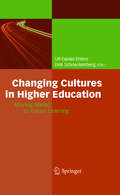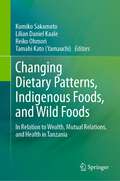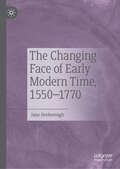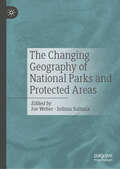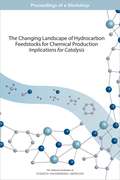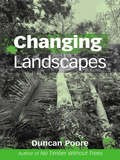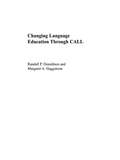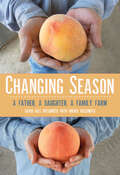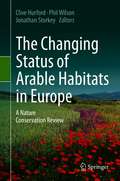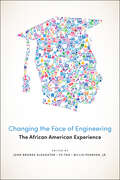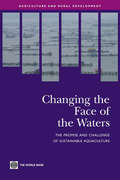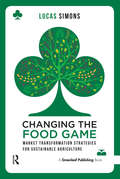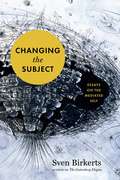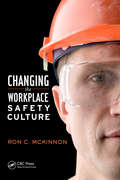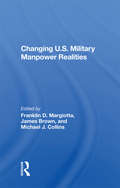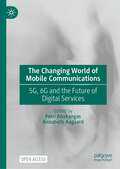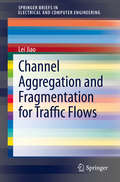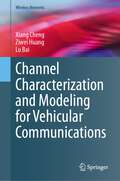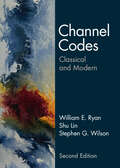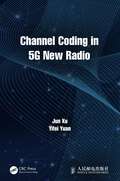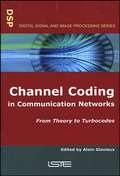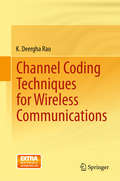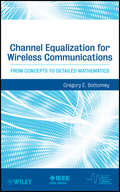- Table View
- List View
Changing Cultures in Higher Education: Moving Ahead to Future Learning
by Ulf-Daniel Ehlers Dirk SchneckenbergMore and more educational scenarios and learning landscapes are developed using blogs, wikis, podcasts and e-portfolios. Web 2.0 tools give learners more control, by allowing them to easily create, share or reuse their own learning materials, and these tools also enable social learning networks that bridge the border between formal and informal learning. However, practices of strategic innovation of universities, faculty development, assessment, evaluation and quality assurance have not fully accommodated these changes in technology and teaching. Ehlers and Schneckenberg present strategic approaches for innovation in universities. The contributions explore new models for developing and engaging faculty in technology-enhanced education, and they detail underlying reasons for why quality assessment and evaluation in new - and often informal - learning scenarios have to change. Their book is a practical guide for educators, aimed at answering these questions. It describes what E-learning 2.0 is, which basic elements of Web 2.0 it builds on, and how E-learning 2.0 differs from Learning 1.0. The book also details a number of quality methods and examples, such as self-assessment, peer-review, social recommendation, and peer-learning, using illustrative cases and giving practical recommendations. Overall, it offers a step-by-step guide for educators so that they can choose their own quality assurance or assessment methods, or develop their own evaluation methodology for specific learning scenarios. The book addresses everyone involved in higher education - university leaders, chief information officers, change and quality assurance managers, and faculty developers. Pedagogical advisers and consultants will find new insights and practices for the integration and management of novel learning technologies in higher education. The volume fosters in lecturers and teachers a sound understanding of the need and strategy for change, and it provides them with practical recommendations on competence and quality methodologies.
Changing Dietary Patterns, Indigenous Foods, and Wild Foods: In Relation to Wealth, Mutual Relations, and Health in Tanzania
by Kumiko Sakamoto Lilian Daniel Kaale Reiko Ohmori Tamahi KatoThis book presents different dietary patterns, some utilizing wild foods and others facing drastically changing dietary patterns, and shows their implications for health in terms of wealth, mutual assistance, food sufficiency and food diversity. The book examines these globally important issues through a case study of Tanzania. Using a novel methodology based on a global standard quality of life indicator, the book sheds light on the relationship between wild food intake and health in Tanzania. Descriptive case studies illustrate the impact of various food patterns and wild food intake on human health. It also highlights the divergence between food production sufficiency and food diversity. It then discusses the influence of wealth, mutual relations, and methods of food access. Finally, the book concludes with recommendations for maintaining good health in various environments. The intended readers of this book are academics and professionals in the fields of development, nutrition, and environment in East Africa. These include, but are not limited to, regional and district personnel who are actively engaged in development, relevant ministries of food and agriculture, and international organizations such as FAO, UNICEF, UNDP, and UNEP. In the academic field, students and researchers in international studies, development studies, African studies, social studies, cultural studies, nutrition, agriculture, and environmental studies are targeted.
The Changing Face of Early Modern Time, 1550–1770
by Jane DesboroughThis book provides a reinterpretation of early modern clock and watch dials on the basis of use. Between 1550 and the emergence of a standard format in 1770, dials represented combinations of calendrical, lunar and astronomical information using multiple concentric rings, subsidiary dials and apertures. Change was gradual, but significant. Over the course of eight chapters and with reference to thirty-five exceptional images, this book unlocks the meaning embedded within these early combinations. The true significance of dial change can only be fully understood by comparing dials with printed paper sources such as almanacs, diagrams and craft pamphlets. Clock and watch makers drew on traditional communication methods, utilised different formats to generate trust in their work, and tried to be help users in different contexts. The calendar, lunar and astronomical functions were useful as a memory prompt for astrology up until the mid-late seventeenth century. After the decline of this practice, the three functions continued to be useful for other purposes, but eventually declined.
The Changing Geography of National Parks and Protected Areas
by Joe Weber Selima SultanaThis book contains recent geographic work examining the changing geography of protected areas in the U.S. and Europe. These places can be national parks, forests, or other places that are being protected for their significant aesthetic, historical, or environmental values by governments and communities. These places can be studied with reference to their physical environments, the management of their plant and animal life, which places are to be protected, who visits these places (and who does not, and why not), and how we think of these places. This work includes examinations of many parks and issues that affect them, such as land degradation, the social and political geography involved in creating new national park units, visitation by underserved segments of the population, and the changing names of protected areas. It makes use of work using methods and data as diverse as remote sensing, nineteenth survey plats and GIS, and online visitor surveys.
The Changing Landscape of Hydrocarbon Feedstocks for Chemical Production: Proceedings of a Workshop
by National Academies of Sciences Engineering MedicineA decade ago, the U.S. chemical industry was in decline. Of the more than 40 chemical manufacturing plants being built worldwide in the mid-2000s with more than 1$ billion in capitalization, none were under construction in the United States. Today, as a result of abundant domestic supplies of affordable natural gas and natural gas liquids resulting from the dramatic rise in shale gas production, the U.S. chemical industry has gone from the world’s highest-cost producer in 2005 to among the lowest-cost producers today. The low cost and increased supply of natural gas and natural gas liquids provides an opportunity to discover and develop new catalysts and processes to enable the direct conversion of natural gas and natural gas liquids into value-added chemicals with a lower carbon footprint. The economic implications of developing advanced technologies to utilize and process natural gas and natural gas liquids for chemical production could be significant, as commodity, intermediate, and fine chemicals represent a higher-economic-value use of shale gas compared with its use as a fuel. To better understand the opportunities for catalysis research in an era of shifting feedstocks for chemical production and to identify the gaps in the current research portfolio, the National Academies of Sciences, Engineering, and Medicine conducted an interactive, multidisciplinary workshop in March 2016. The goal of this workshop was to identify advances in catalysis that can enable the United States to fully realize the potential of the shale gas revolution for the U.S. chemical industry and, as a result, to help target the efforts of U.S. researchers and funding agencies on those areas of science and technology development that are most critical to achieving these advances. This publication summarizes the presentations and discussions from the workshop.
Changing Landscapes: The Development of the International Tropical Timber Organization and Its Influence on Tropical Forest Management
by Duncan PooreThis is the history of the International Tropical Timber Organization (ITTO); its aims, policies and achievements, through drawing on contemporary records and the author's own wide experience. The book uses examination of past successes and failures to formulate a 21st-century agenda for the most practical ways of improving the management of forests and deciding forest policies.
Changing Language Education Through CALL (Routledge Studies in Computer Assisted Language Learning #Vol. 1)
by Randall P. Donaldson Margaret A. HaggstromThe last twenty years has seen a huge evolution in approaches to language-learning, due to new technology as well changing theories on how to best teach languages. Recognising the key relationship between research, practice and program development, Changing Language Education Through CALL is an important text advocating change that makes effective use of new research into learning styles, as well as new technology. Bringing together sixteen internationally respected experts in second-language acquisition and computer technologies, it presents teachers with user-friendly, flexible ways to incorporate technology into the language learning process and provides both the theoretical and practical basis for CALL applications across a broad spectrum of teaching styles, textbooks and courses. Practical and clearly presented, each chapter in this book concentrates on the learning process and the teacher’s role in facilitating this through the proper and effective use of technology - thus ensuring that the partnership of pedagogical expertise and technological innovation remains the work’s focus.
Changing Season: A Father, A Daughter, A Family Farm
by Nikiko Masumoto David MasumotoHow do you become a farmer? The real questions are: what kind of person do you want to be? Are you willing to change? How do you learn? What is your vision for the future? In this poignant collection of essays, Epitaph for a Peach author David Mas Masumoto gets ready to hand his eighty-acre organic farm to his daughter, Nikiko, after four decades of working the land. Declaring that “all of the gifts I have received from this life are not only worthy of sharing, but must be shared,” Mas reflects on topics as far-ranging as the art of pruning, climate change, and the prejudice his family faced during and after World War II: essays that, whether humorous or heartbreaking, explore what it means to pass something on. Nikiko's voice is present, too, as she relates the myriad lessons she has learned from her father in preparation for running the farm as a queer mixed-race woman. Both farmers feel less than totally set for the future that lays ahead; indeed, Changing Season addresses the uncertain future of small-scale agriculture in California. What is unquestionable, though, is the family's love for their vocation—and for each other.
The Changing Status of Arable Habitats in Europe: A Nature Conservation Review
by Clive Hurford Phil Wilson Jonathan StorkeyThis edited volume documents the current nature conservation status of arable habitats in Europe. Arable farming systems have evolved in the European landscape over more than ten thousand years and now occupy nearly 30% of the European land area. They support species that have life cycles closely synchronised with traditional cereal growing, many of which have experienced massive declines throughout Europe. For example, in Britain, of the 100 plant species exhibiting the greatest declines in the latter half of the 20th century, 47 were typical of arable land. Despite this the habitat and many of the species associated with it remains unprotected across much of Europe. The 22 chapters cover a range of topics, including: · Regional accounts describing the impact of changing agricultural practices on the arable flora;· The results of research and surveillance projects on the soil organisms, bryophyte flora, invertebrate fauna and pollinators of arable habitats;· The potential for designing multifunctional and resilient agricultural landscapes; The use of ex situ conservation to aid the reintroduction of rare arable plants;· Case studies illustrating how changing agricultural practices have impacted on bird populations in Europe; · The roles of remote sensing in monitoring agricultural systems; · How agri-environment schemes can help restore the biodiversity in arable habitats; and · A look forward at ways to help ensure the future security of the species associated with arable habitats. It is clear that the biodiversity of arable land throughout Europe has undergone major changes, particularly during the second half of the 20th century, and that these changes are continuing into the 21st century. We need to develop a deeper appreciation of farmland wildlife and its integration into farming systems to ensure its future security in a world where value is increasingly expressed in terms of material profit. This book is particularly relevant to practitioners, policy-makers and managers working in the fields of nature conservation, agri-environment schemes and land management, and to researchers working in the fields of conservation biology, terrestrial ecology, nature conservation, applied ecology, biodiversity, agriculture, agricultural ethics and environmental studies.
Changing the Face of Engineering: The African American Experience
by Editors: John Brooks Slaughter, Yu Tao, and Willie Pearson, Jr.How can academic institutions, corporations, and policymakers foster African American participation and advancement in engineering?For much of America’s history, African Americans were discouraged or aggressively prevented from becoming scientists and engineers. Those who did enter STEM fields found that their inventions and discoveries were often neither recognized nor valued. Even today, particularly in the field of engineering, the participation of African American men and women is shockingly low, and some evidence indicates that the situation might be getting worse.In Changing the Face of Engineering, twenty-four eminent scholars address the underrepresentation of African Americans in engineering from a wide variety of disciplinary and professional perspectives while proposing workable classroom solutions and public policy initiatives. They combine robust statistical analyses with personal narratives of African American engineers and STEM instructors who, by taking evidenced-based approaches, have found success in graduating African American engineers.Changing the Face of Engineering argues that the continued underrepresentation of African Americans in engineering impairs the ability of the United States to compete successfully in the global marketplace. This volume will be of interest to STEM scholars and students, as well as policymakers, corporations, and higher education institutions.
Changing the Face of the Waters: The Promise and Challenge of Sustainable Aquaculture
by World BankAquaculture--the farming of fish and aquatic plants--has become the world's fastest-growing food production sector, even as the amount of wild fish caught in our seas and fresh waters declines. From fish foods and pharmaceuticals to management of entire aquatic ecosystems, acquaculture is truly changing the face of the waters. Increased growth, however, brings increased risk, and aquaculture now lies at a crossroads. One direction points toward the giant strides in productivity, industry concentration, and product diversification. Another direction points toward the dangers of environmental degradation and the marginalization of small fish farmers. Yet another direction invites aquaculture to champion the poor and provide vital environmental services to stressed aquatic environments. 'Changing the Face of the Waters' offers a cutting-edge analysis of the critical challenges facing aquaculture, balancing aquaculture's role in economic growth with the need for sound management of natural resources. The book also provides guidance on sustainable aquaculture by evaluating alternative development pathways, placing particular emphasis on the application of lessons from Asia to Sub-Saharan Africa and Latin America. Aimed at policy makers, planners, and scientists, this book provides a comprehensive frame of reference for orienting ideas and initiatives in this dynamic industry.
Changing the Food Game: Market Transformation Strategies for Sustainable Agriculture
by Lucas SimonsBy 2050, the world’s population is estimated to grow to 10 billion. To feed everyone, we will have to double our food production, to produce more food in the next 40 years than in the whole of the last 6,000. Changing the Food Game shows how our unsustainable food production system cannot support this growth. In this prescient book, Lucas Simons argues that the biggest challenge for our generation can only be solved by effective market transformation to achieve sustainable agriculture and food production. Lucas Simons explains clearly how we have created a production and trading system that is inherently unsustainable. But he also demonstrates that we have reason to be hopeful – from a sustainability race in the cocoa industry to examples of market transformation taking place in palm oil, timber, and sugarcane production. He also poses the question: where next? Provocative and eye-opening, Changing the Food Game uncovers the real story of how our food makes it on to our plates and presents a game-changing solution to revolutionize the industry.
Changing the Subject: Art and Attention in the Internet Age
by Sven BirkertsTrenchant, expansive essays on the cultural consequences of ongoing, all-permeating technological innovationIn 1994, Sven Birkerts published The Gutenberg Elegies, his celebrated rallying cry to resist the oncoming digital advances, especially those that might affect the way we read literature and experience art—the very cultural activities that make us human. After two decades of rampant change, Birkerts has allowed a degree of everyday digital technology into his life. He refuses to use a smartphone, but communicates via e-mail and spends some time reading online. In Changing the Subject, he examines the changes that he observes in himself and others—the distraction when reading on the screen; the loss of personal agency through reliance on GPS and one-stop information resources; an increasing acceptance of "hive" behaviors. "An unprecedented shift is underway," he argues, and "this transformation is dramatically accelerated and more psychologically formative than any previous technological innovation." He finds solace in engagement with art, particularly literature, and he brilliantly describes the countering energy available to us through acts of sustained attention, even as he worries that our increasingly mediated existences are not conducive to creativity. It is impossible to read Changing the Subject without coming away with a renewed sense of what is lost by our wholesale acceptance of digital innovation and what is regained when we immerse ourselves in a good book.
Changing the Workplace Safety Culture (Workplace Safety, Risk Management, and Industrial Hygiene)
by Ron C. McKinnonDespite the fact that workplaces have implemented and followed new safety innovations and approaches, the majority of them have seen little, if any, significant progress in the reduction of accidental deaths and injuries. Changing the Workplace Safety Culture demonstrates that changing the way an organization views and practices safety will impact
Changing U.s. Military Manpower Realities
by Franklin D. Margiotta James Brown Michael J. CollinsManpower—qualified, experienced, and in adequate supply—is considered by many to be the keystone of the U.S. capability to deter or wage war. But can the all-volunteer force (AVF) continue to attract and retain the quantity and quality of active and reserve forces required to meet the security needs of the nation? The contributors to this collectio
The Changing World of Mobile Communications: 5G, 6G and the Future of Digital Services
by Petri Ahokangas Annabeth AagaardThis open access book from the world’s first 6G Flagship research program at the University of Oulu, Finland, provides a multi-disciplinary and insightful overview of the subject, with contributions from experts in the field. Today’s fourth generation of mobile connectivity services (4G) are available everywhere, and adoption of fifth generation (5G) networks is well underway. Compared to 4G, 5G has already brought about new business opportunities and enabled seamless virtual and augmented reality services, but also raised serious concerns on data privacy and security and the use of artificial intelligence. The sixth generation (6G) networks are already in R&D phase aiming at deployment in 2030. We need to understand today what 5G evolution and 6G may bring for the future of service delivery and how they will influence us. The contributions answer what 5G, its evolution, and 6G will be about; what kind of impacts 5G and 6G will have on future digital services, businesses, and society; how we could benefit from 5G and 6G innovations; and how 5G and 6G should be regulated in the future. Future 5G evolution and 6G are not only about moving toward faster, better, and more secure networks providing the basis for innovative digital services, they are also going to bring about a huge digital disruption that will affect all levels of society. This book will be of great interest to academics and students of management, telecommunications and digital innovation, as well practitioners and policymakers looking to the future of business.
Channel Aggregation and Fragmentation for Traffic Flows (SpringerBriefs in Electrical and Computer Engineering)
by Lei JiaoThis book introduces the impact of channel aggregation (CA) and channel fragmentation (CF) on traffic flows, through analytical models, computer simulations, and test-bed implementations. Its content includes the concept of CA and CF, the basic concept and calculation of Markov chains (MCs), the modeling process of the CA and CF enabled system via MCs, the process of simulations, and a test-bed study based on a software defined radio.This book can serve as a study guide for advanced-level students, who are interested in studying the impact of CA and CF techniques on traffic flows. This book would also interest communication engineers, who would like to learn MC modeling for performance evaluations, as it includes a step-by-step guidance for the modeling process via MCs, as well as its simulation approaches.
Channel Characterization and Modeling for Vehicular Communications (Wireless Networks)
by Xiang Cheng Ziwei Huang Lu BaiThis book presents and develops comprehensive knowledge of vehicular channel characteristics and proper vehicular channel models. The studied topics contain the propagation characteristics of vehicular communications, such as: a time-frequency non-stationary single-input single-output (SISO) vehicle-to-vehicle (V2V) non-geometry stochastic model (NGSM); a space-time non-stationary massive multiple-input multiple-output (MIMO) V2V regular-shaped geometry-based stochastic model (RS-GBSM); and a space-time non-stationary massive MIMO V2V irregular-shaped geometry-based stochastic model (IS-GBSM). Each is introduced, with characteristics then discussed in detail. Finally, this book discusses future research directions to inspire further investigation in the field of vehicular channels from three different perspectives.
Channel Codes
by William E. Ryan Shu LinChannel coding lies at the heart of digital communication and data storage, and this detailed introduction describes the core theory as well as decoding algorithms, implementation details, and performance analyses. Known for their writing clarity, Professors Ryan and Lin provide the latest information on modern channel codes, including turbo and low-density parity-check (LDPC) codes. They also present detailed coverage of BCH codes, Reed-Solomon codes, convolutional codes, finite geometry codes, and product codes, providing a one-stop resource for both classical and modern coding techniques. Assuming no prior knowledge in the field of channel coding, the opening chapters begin with basic theory to introduce newcomers to the subject. Later chapters then extend to advanced topics such as code ensemble performance analyses and algebraic code design. 250 varied and stimulating end-of-chapter problems are also included to test and enhance learning, making this an essential resource for students and practitioners alike.
Channel Codes: Classical and Modern
by William E. Ryan Shu Lin Stephen G. WilsonChannel coding lies at the heart of digital communication and data storage. Fully updated, including a new chapter on polar codes, this detailed introduction describes the core theory of channel coding, decoding algorithms, implementation details, and performance analyses. This new edition includes over 50 new end-of-chapter problems and new figures and worked examples throughout. The authors emphasize the practical approach and present clear information on modern channel codes, including turbo and low-density parity-check (LDPC) codes, detailed coverage of BCH codes, Reed-Solomon codes, convolutional codes, finite geometry codes, product codes as well as polar codes for error correction and detection, providing a one-stop resource for classical and modern coding techniques. Assuming no prior knowledge in the field of channel coding, the opening chapters begin with basic theory to introduce newcomers to the subject. Later chapters then extend to advanced topics such as code ensemble performance analyses and algebraic code design.
Channel Coding in 5G New Radio
by Jun Xu Yifei YuanThis book provides a comprehensive coverage of major channel codes adopted since the 3rd generation of mobile communication. Modulation schemes suitable for 5G mobile communications are also described based on key New Radio application scenarios and performance requirements. It covers low density parity check (LDPC) codes, Polar codes, tail-biting convolutional codes (TBCC) and Turbo codes. Outer codes and a few advanced coding and modulations are also discussed. In addition, it includes detailed illustration of each channel coding scheme such as the basic code structure, decoding algorithms, performance evaluation and complexity analysis. The book offers insights on why and how channel codes are designed and developed in standardization organizations, which significantly facilitates the reading and understanding of the of 5G channel coding technologies. Channel Coding in 5G New Radio will be an essential read for researchers and students of digital communications, wireless communications engineers, and those who are interested in mobile communications in general.
Channel Coding in Communication Networks: From Theory to Turbocodes (Wiley-iste Ser.)
by Alain GlavieuxThis book provides a comprehensive overview of the subject of channel coding. It starts with a description of information theory, focusing on the quantitative measurement of information and introducing two fundamental theorems on source and channel coding. The basics of channel coding in two chapters, block codes and convolutional codes, are then discussed, and for these the authors introduce weighted input and output decoding algorithms and recursive systematic convolutional codes, which are used in the rest of the book. Trellis coded modulations, which have their primary applications in high spectral efficiency transmissions, are then covered, before the discussion moves on to an advanced coding technique called turbocoding. These codes, invented in the 1990s by C. Berrou and A. Glavieux, show exceptional performance. The differences between convolutional turbocodes and block turbocodes are outlined, and for each family, the authors present the coding and decoding techniques, together with their performances. The book concludes with a chapter on the implementation of turbocodes in circuits. As such, anyone involved in the areas of channel coding and error correcting coding will find this book to be of invaluable assistance.
Channel Coding Techniques for Wireless Communications
by K. Deergha RaoThe book discusses modern channel coding techniques for wireless communications such as turbo codes, low parity check codes (LDPC), space-time coding, Reed Solomon (RS) codes and convolutional codes. Many illustrative examples are included in each chapter for easy understanding of the coding techniques. The text is integrated with MATLAB-based programs to enhance the understanding of the subject's underlying theories. It includes current topics of increasing importance such as turbo codes, LDPC codes, LT codes, Raptor codes and space-time coding in detail, in addition to the traditional codes such as cyclic codes, BCH and RS codes and convolutional codes. MIMO communications is a multiple antenna technology, which is an effective method for high-speed or high-reliability wireless communications. PC-based MATLAB m-files for the illustrative examples are included and also provided on the accompanying CD, which will help students and researchers involved in advanced and current concepts in coding theory. Channel coding, the core of digital communication and data storage, has undergone a major revolution as a result of the rapid growth of mobile and wireless communications. The book is divided into 11 chapters. Assuming no prior knowledge in the field of channel coding, the opening chapters (1 - 2) begin with basic theory and discuss how to improve the performance of wireless communication channels using channel coding. Chapters 3 and 4 introduce Galois fields and present detailed coverage of BCH codes and Reed-Solomon codes. Chapters 5-7 introduce the family of convolutional codes, hard and soft-decision Viterbi algorithms, turbo codes, BCJR algorithm for turbo decoding and studies trellis coded modulation (TCM), turbo trellis coded modulation (TTCM), bit-interleaved coded modulation (BICM) as well as iterative BICM (BICM-ID) and compares them under various channel conditions. Chapters 8 and 9 focus on low-density parity-check (LDPC) codes, LT codes and Raptor codes. Chapters 10 and 11 discuss MIMO systems and space-time (ST) coding.
Channel Coding Techniques for Wireless Communications (Forum for Interdisciplinary Mathematics)
by K. Deergha RaoThis book discusses the latest channel coding techniques, MIMO systems, and 5G channel coding evolution. It provides a comprehensive overview of channel coding, covering modern techniques such as turbo codes, low-density parity-check (LDPC) codes, space–time coding, polar codes, LT codes, and Raptor codes as well as the traditional codes such as cyclic codes, BCH, RS codes, and convolutional codes. It also explores MIMO communications, which is an effective method for high-speed or high-reliability wireless communications. It also examines the evolution of 5G channel coding techniques. Each of the 13 chapters features numerous illustrative examples for easy understanding of the coding techniques, and MATLAB-based programs are integrated in the text to enhance readers’ grasp of the underlying theories. Further, PC-based MATLAB m-files for illustrative examples are included for students and researchers involved in advanced and current concepts of coding theory.
Channel Equalization for Wireless Communications: From Concepts to Detailed Mathematics
by Gregory E. BottomleyThe most thorough, up-to-date reference on channel equalization--from basic concepts to complex modeling techniquesIn today's instant-access society, a high premium is placed on information that can be stored and communicated effectively. As a result, storage densities and communications rates are being pushed to capacity, causing information symbols to interfere with one another. To help unclog pathways for the clearer conveyance of information, this book offers in-depth discussion of the significant contributions and future adaptability of channel equalization and a set of approaches for solving the problem of intersymbol interference (ISI). Chapter explorations in Channel Equalization include:Channel equalization topics presented with incremental learning methodology--from the very fundamental concept to more advanced mathematical knowledgeCoverage of technology used in second-, third- and fourth-generation cellular communication systemsA set of homework problems that reinforce concepts discussed in the bookTutorial explanations of recent developments currently captured in IEEE technical journalsUnlike existing digital communications books that devote cursory attention to channel equalization, this invaluable guide addresses a crucial need by focusing solely on the background, current state, and future direction of this increasingly important technology. A unique mix of basic concepts and complex frameworks for delivering digitized data make Channel Equalization a valuable reference for all practicing wireless communication engineers and students dealing with the pressing demands of the information age.
